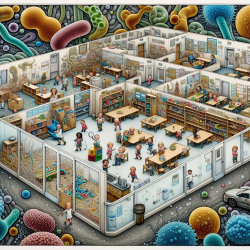Introduction
As a Special Education Director, ensuring the well-being of children in educational settings is a priority. Recent research into the bacterial communities within childcare centers offers valuable insights that can enhance our understanding of microbial exposure in these environments. The study titled "The bacterial community of childcare centers: potential implications for microbial dispersal and child exposure" provides a comprehensive analysis of how these microbial communities are structured and their potential impact on child health.
Key Findings from the Research
The research conducted by Beasley et al. (2022) highlights several important findings:
- Human-Associated Bacteria Dominance: The bacterial communities within childcare centers are predominantly human-associated, with significant input from skin and oral bacteria.
- Surface Variability: There is a notable difference in bacterial communities between high-contact and low-contact surfaces within classrooms, with high-contact surfaces showing a greater abundance of human-associated bacteria.
- Environmental Influence: Despite proximity to outdoor environments, the bacterial communities inside classrooms differ significantly from those outside, indicating limited outdoor microbial influence.
- Occupant Density Impact: The density of children in a classroom correlates with variations in bacterial communities, suggesting that occupancy levels play a role in microbial dispersal.
Practical Implications for Practitioners
Understanding these findings can aid practitioners in creating healthier environments for children. Here are some practical steps that can be implemented:
- Enhanced Cleaning Protocols: Focus on high-contact surfaces such as desks and door handles to reduce the spread of human-associated bacteria.
- Ventilation Improvements: Consider architectural designs that enhance ventilation to potentially reduce indoor microbial load.
- Occupancy Management: Monitor and manage classroom occupancy to minimize microbial exposure, especially in high-density settings.
- Further Research Encouragement: Engage in or support further research to explore the impact of different cleaning agents and environmental designs on microbial communities.
Conclusion
The study by Beasley et al. provides critical insights into the microbial dynamics within childcare centers. By implementing these findings, practitioners can enhance the health and safety of educational environments. As we continue to explore the microbiome of built environments, it is crucial to adapt our practices to ensure the well-being of young children.
To read the original research paper, please follow this link: The bacterial community of childcare centers: potential implications for microbial dispersal and child exposure.










